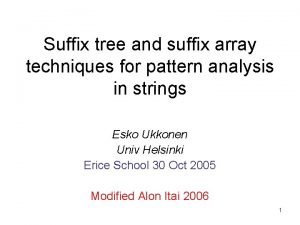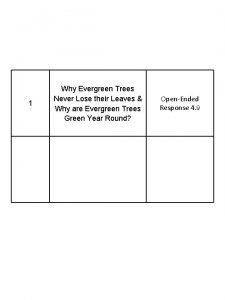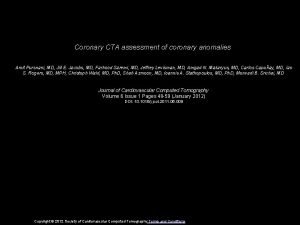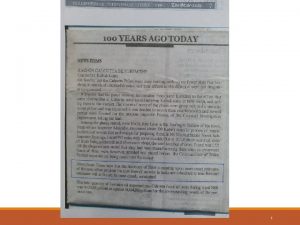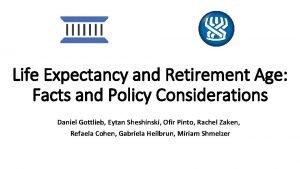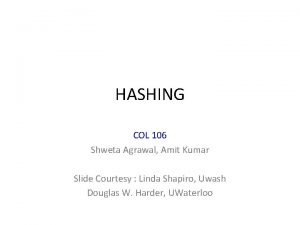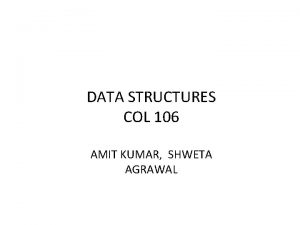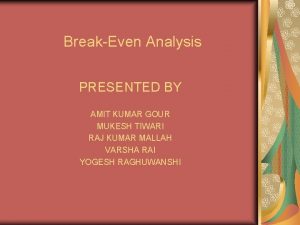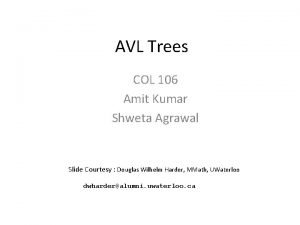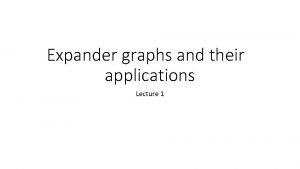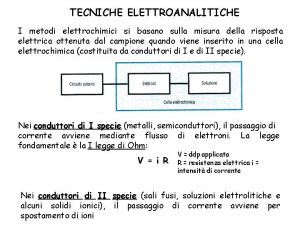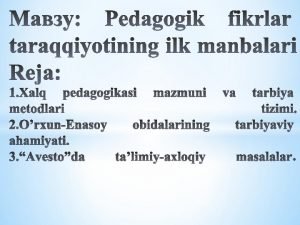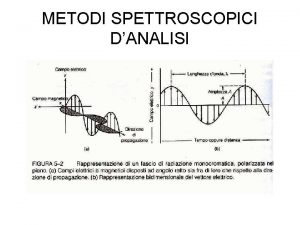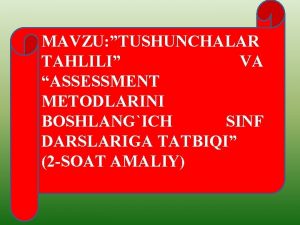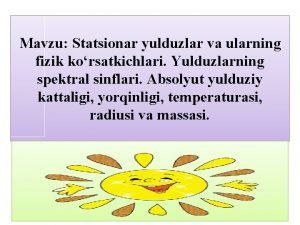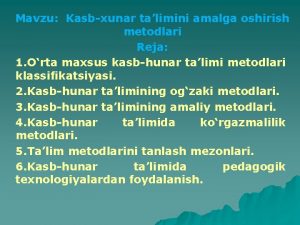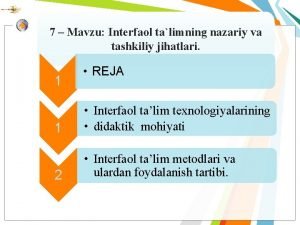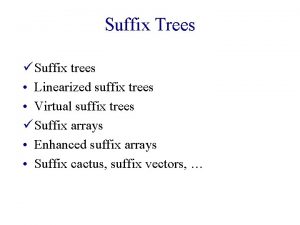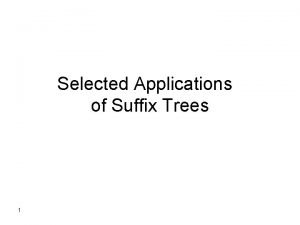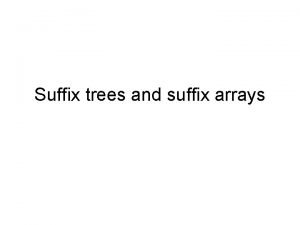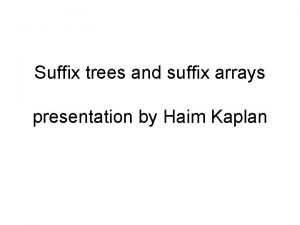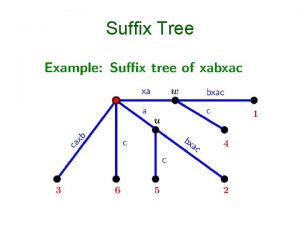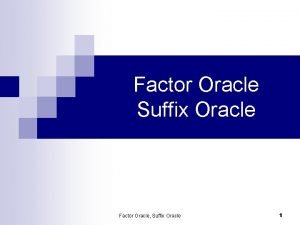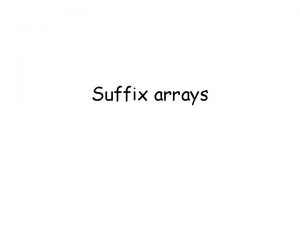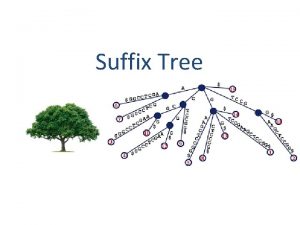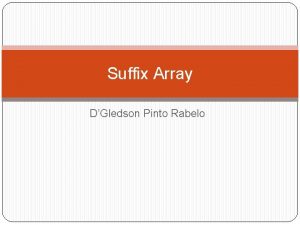Suffix Trees and their applications Amit Metodi and




![Suffix Tree � A suffix tree of string S[1. . n] is a compressed Suffix Tree � A suffix tree of string S[1. . n] is a compressed](https://slidetodoc.com/presentation_image_h/aac79f836243d3e3e9f3253b115c6567/image-5.jpg)

































































- Slides: 70

Suffix Trees and their applications Amit Metodi and Tali Weinberger Seminar 2012/1

Outline �Introduction to Suffix Trees ◦ ◦ ◦ Trie and Compressed Trie Suffix Tree Trivial Construction Algorithm O(N^2) Exact string matching Generalized suffix tree �Applications

Trie � A tree representing a set of strings. (Assume no string is a prefix of another) � Each edge is labeled by a letter. a b � No two edges outgoing from the same node are labeled the same. d e “aeef “ b e � Each string corresponds to a leaf. f c f e g { “aeef “ , “ad“ , “bbfe “ , “bbfg “ , “c “ }

Compressed Trie � Compress unary nodes, label edges by strings. All internal non-root nodes are c a b branching, there can be at most n− 1 such nodes, and n+(n− 1)+1= 2 n nodes in total d e b (n leaves, n− 1 internal nodes, 1 root). e f c a d eef bbf f e g e { “aeef “ , “ad“ , “bbfe “ , “bbfg “ , “c “ } g
![Suffix Tree A suffix tree of string S1 n is a compressed Suffix Tree � A suffix tree of string S[1. . n] is a compressed](https://slidetodoc.com/presentation_image_h/aac79f836243d3e3e9f3253b115c6567/image-5.jpg)
Suffix Tree � A suffix tree of string S[1. . n] is a compressed trie of all suffixes of S. � Denote S[i. . n] by Si a S = “x a b x a c” c 1 2 3 4 5 6 xa 6 { c S 6= c S 5= ac 5 bxac S 4= xac Does a suffix tree S 3= bxac always exist ? bxac S 2= abxac 3 S 1= xabxac 2 } 1 c 4

Suffix Tree S = “x a b x a” 1 2 3 4 5 { S 5= a S 4= xa S 3= bxa S 2= abxa S 1= xabxa } a xa 5 4 bxa bxa 3 2 1 The fourth suffix xa or the fifth suffix a won’t be represented by a leaf node.

Suffix Tree � Solution: insert a special terminal character at the end such as $. � Then, xa$ will not be a prefix of the suffix xabxa$. S = “x a b x a $” 1 2 3 4 5 6 { S 6= $ S 5= a$ S 4= xa$ S 3= bxa$ S 2= abxa$ S 1= xabxa$ } a $ xa 6 $ 5 bxa$ $ bxa$ 3 2 1 4

Trivial algorithm to build Suffix tree Build suffix tree S=xaxac (S’=xaxac$) �Put the largest suffix xaxac$ �Put the suffix xac$ x a c $ a x a c $

Trivial algorithm to build Suffix tree Build suffix tree S=xaxac (S’=xaxac$) �Put the largest suffix xaxac$ �Put the suffix ac$ x a c $ a x a c $

Trivial algorithm to build Suffix tree Build suffix tree S=xaxac (S’=xaxac$) �Put the largest suffix xaxac$ �Put the suffix c$ �Put the smallest suffix $ �Label each leaf with the starting point. $ 6 x a c $ 1 c$ a x a c $ 3 5 c$ x a c $ 2 4

Complexity – Run Time � We need O(n-i+1) time for the ith suffix. Therefore the total running time is: � Ukkonen in 1995 provided the first online- construction of suffix trees with the running time that matched then fastest algorithms. These algorithms are all linear-time for a constant-size alphabet, and have worst-case running time of O(nlogn) in general. � Martin Farach in 1997 gave the first suffix tree construction algorithm that is optimal for all alphabets O(n)

Complexity - Space � Will also take O(n 2) if we would store every suffix in the tree separately. � Note that, we should not store the actual substrings S[i. . . j] of S in the edges, but only their start and end indices (i, j). � Nevertheless we keep thinking of the edge labels as substrings of S. � This will reduce the space complexity to O(n)

Exact string matching �Given S and P strings where |S|=n and |P|=m. Find all occurrences of P in S. S= m i s s i p p 1 2 3 4 5 6 7 8 9 10 11 i si si si ii s P= �Naïve algorithm = O(n*m) s i i

Exact string matching �Given S and P strings where |S|=n and |P|=m. Find all occurrences of P in S. Using suffix tree: 1. Build suffix tree O(n) p i s s 3. All leaves below x represent occurrences of P. i O(k) (where k = number of occurrences of P in S) p p i $ 2 $ 11 p p i $ 5 sippi$ 8 s s i missis 2. Try to match P on a path. Three cases: a. No match → P does not occur in T. p b. The match of P ends in a node u. Set x = u. p c. The match ends inside an edge (v, w). Set x=w. i $ O(m) Total time: O(n+m+k) ~= O(n) s 1

Generalized suffix tree �Given a set of strings T a generalized suffix tree of T is a compressed trie of all suffixes of S T. �To make these suffixes prefix-free we add a special char at the end of S. �To associate each suffix with a unique string in T, add a different special char to each S T.

Generalized suffix tree �Let S 1=abab and S 2=aab here is a generalized suffix tree for S 1 and S 2 $ { } a 5 $ b$ ab$ bab$ abab$ # b# aab# # b a b $ 1 b a b # $ 3 # 1 2 4 # $ a b $ 4 2 3

Applications of suffix trees �Longest Common Substring ◦ DNA Contamination Problem �Maximal Repetitive Structures �Longest common extension �Finding maximal palindromes �The k-mismatch problem

Longest Common Substring �Given strings A and B find the longest substring common to both strings. �String A= lambada Donald E. Knuth �String B=abady conjectured in �Longest Common Substring = bad 1970 that It is impossible to solve this Longest Common Substring problem in O(|A|+|B|) time.

LCSubstring - Idea �Construct a suffix tree T for A#B$, where # and $ are two characters not in A and B. �There are exactly |A|+|B|+2 leaves in T, each leaf corresponds to a suffix of A#B$. ◦ A-leaf: with label in {1, 2, …, |A|} �corresponds to an A-suffix. ◦ B-leaf: with label in {|A|+2, …, |A|+|B|+1} �corresponds to a B-suffix A # B $ A-suffix

LCSubstring - Observation �Let v be an arbitrary position of T (i. e. , v is not necessarily a node of T. ) ◦ v has a descendant A-leaf if and only if v corresponds to a prefix of an A-suffix of A#B$. ◦ v has a descendant B-leaf if and only if v corresponds to a prefix of a B-suffix of A#B$. root v

LCSubstring - Lemma �Let v be a position of T. v has descendant A-leaf and B-leaf if and only if v corresponds to a common substring of A and B. v A # v v B-suffix B root $ A-suffix

LCSubstring – Algorithm �Construct a suffix tree T for A#B$. O(|A|+|B|) �Marking the colors of each node, including Single each leaf and each internal nodes. O(|A|+|B|) DFS �Computing the depths of all nodes. O(|A|+|B|) �Find a deepest internal node with both colors. O(|A|+|B|) �Output the string corresponding to the deepest internal node v such that the subtree of T rooted at v contains both A-leaf and B-leaf. �Time: O(|A|+|B|) Space can be reduced to �Space: O(|A|+|B|) O(|A|)

LCSubstring - Example �Let A=aabcy and B=abab, here is a generalized suffix tree for A and B. { $ b$ ab$ bab$ abab$ } *# 6 #* y#* cy#* bcy#* aabcy#* $ y #* a c y #* b 11 b c a b $ 7 a y $ # * 9 2 4 c y #* b c y # * 1 a b $ 8 $ 10 5 3

LCSubstring - Example �Let A=aabcy and B=abab, here is a generalized suffix tree for A and B. { $ b$ ab$ bab$ abab$ } # 6 # y# cy# bcy# aabcy# $ 5 a b $ 1 a c y $ # 3 2 cy# b 1 2 y# 0 1 b c y # 1 a b $ 2 4 c y# $ 4 5 3

DNA Contamination Problem DNA contamination: During laboratory processes, unwanted DNA inserted into the DNA of interest. Contamination sources: Human, bacteria, … DNA from Dinosaur bone: More similar to human DNA than to bird and crockodilian DNA

DNA Contamination Problem S: DNA of interest P: DNA of possible contamination source If S and P share a common substring longer than l, then S has been contaminated by P. To find all common substrings of S and P that are longer than l. In general, P is set of DNA that are potential contamination sources.

Applications of suffix trees �Longest Common Substring ◦ DNA Contamination Problem �Maximal Repetitive Structures �Longest common extension �Finding maximal palindromes �The k-mismatch problem

Maximal Repetitive Structures 28

Maximal Pair � A maximal pair in string S: A pair of identical substrings a and b in S s. t. the characters to the immediate left and right of a is different from the characters to the immediate left and right of b, respectively. � That is, Extending a and b in either direction would destroy the equality of the two strings. � Example: S = xabcyiiizabcqabcyrxar 29

Maximal Pair (continued) � Overlap is allowed: S = cxxaxxaxxb cxxaxxa axxaxxb � To allow a prefix or suffix of S to be part of a maximal pair: S #S$ (#, $ don’t appear in S). Example: #abcxabc$ 30

Maximal Repeat � A maximal repeat in string S: A substring of S that occurs in a maximal pair in S. � Example: S = xabcyiiizabcqabcyrxar maximal repeats: abc, abcy, . . . 31

Finding All Maximal Repeats In Linear Time � Given: String S of length n. � Goal: Find all maximal repeats in O(n) time. � Lemma: Let T be a suffix tree for S. If string a is a maximal repeat in S, then a is the path-label of an internal node v in T. 32

Proof – by def. of maximal repeat S = xabcyiiizabcqabcyrxar root a a b c v y q A maximal repeat in string S: A substring of S that occurs in a maximal pair in S. 33

Observation � T has at most n internal nodes. � Why? Since T has n leaves (one for each index), and each internal node other than the root must have at least two children, T can have at most n internal nodes. 34

Conclusion � There can be at most n maximal repeats in any string of length n. � Proof: by the lemma, since T has at most n internal nodes. 35

Which internal nodes correspond to maximal repeats? � The left character of leaf i in T is S(i-1). � Node v of T is called left diverse if at least 2 leaves in v’s subtree have different left characters. � A leaf can’t be left diverse. � Left diversity propagates upward. 36

Example: S = #xabxa$ 1 2 3 4 5 6 xa bxa$ max im left diverse al re peat a $ 3 6 a a bxa$ $ 5 22 x x bxa$ $ 44 b 1 # 37

Theorem The string a labeling the path to an internal node v of T is a maximal repeat v is left diverse. 38

Proof of � Suppose a is a maximal repeat � It participates in a maximal pair � It has at least two occurrences with distinct left characters: xa, ya, x y � Let i and j be the two starting positions of a. Then leaves i and j are in v’s subtree and have different left characters x, y. � v is left diverse. 39

Proof of � Suppose v is left diverse there are substrings xap and yaq in S, x y. � If p q a’s occurrences in xap and yaq form a maximal pair a is a maximal repeat. � If p=q since v is a branching node, there is a substring zar in S, r p. If z x It forms a maximal pair with xap. If z y It forms a maximal pair with yap. In either case, a is a maximal repeat. These cases cover all the cases, since x y. 40

Proof of (continued) root Case 1: Case 2: root a a v p… left char x v r. . . q… left char y left char z left char x p. . . left char y 41

Compact Representation � Node v in T is a frontier node if: ◦ v is left diverse. ◦ none of v’s children are left diverse. � Each node at or above the frontier is left diverse. � The subtree of T from the root down to the frontier nodes is the compact representation of the set of all maximal repeats of S. � Representation in O(n) though total length of all maximal repeats may be larger. 42

Linear time algorithm � Build suffix tree T. � Find all left diverse nodes in linear time. � Delete all nodes that aren’t left diverse, to achieve the compact representation. 43

finding all left diverse nodes in linear time � Traverse T bottom-up, recording for each node: ◦ either that it is left diverse ◦ or the left character common to all leaves in its subtree. � For each leaf: record its left character. � For each internal node v: ◦ If any child is left diverse v is left diverse. ◦ Else If all children have a common character x record x for v. �Else record that v is left diverse. 44

Time Analysis � Suffix tree construction O(n). � Bottom-up traversal O(n). � Total O(n). 45

Applications of suffix trees �Longest Common Substring ◦ DNA Contamination Problem �Maximal Repetitive Structures �Longest common extension �Finding maximal palindromes �The k-mismatch problem

Longest common extension: a bridge to inexact matching

Longest common extension problem Preprocess strings S 1 and S 2 s. t. the following queries can be computed in O(1) time each: � Given index pair (i, j), find the length of the longest substring of S 1 starting at position i that matches a substring of S 2 starting at position j. S 1: . . . abcdzzz. . . S 2: . . . abcdefg . . . j i 48

Lowest common ancestors A lot more can be gained from a suffix tree if we preprocess it so that we can answer LCA queries on it

Why to find LCA? For two suffixes of S, we can compute their Longest Common Prefix by finding the LCA of the corresponding leaves in the suffix tree. LCP(ippi$, issippi$)= $ p s iss ipp i$ i m 12 ssi $ $ ppi$ 9 ppi$ 7 4 6 $ ppi$ i$ 2 10 si i ipp 5 ssippi$ ss ppi$ 11 i$ ssi 8 1 3

Why to find LCA? For two suffixes of S, we can compute their Longest Common Prefix by finding the LCA of the corresponding leaves in the suffix tree. LCP(ippi$, issippi$)= $ p s iss ipp i$ i m 12 ssi $ $ ppi$ 9 ppi$ 7 4 6 $ ppi$ i$ 2 10 si i ipp 5 ssippi$ ss ppi$ 11 i$ ssi 8 1 3

Why to find LCA? For two suffixes of S, we can compute their Longest Common Prefix by finding the LCA of the corresponding leaves in the suffix tree. LCP(ippi$, issippi$)= i $ p s iss ipp i$ i m 12 ssi $ $ ppi$ 9 ppi$ 7 4 6 $ ppi$ i$ 2 10 si i ipp 5 ssippi$ ss ppi$ 11 i$ ssi 8 1 3

Lowest common ancestors after a linear amount of preprocessing of a rooted tree, for any two specified nodes, their lowest common ancestor can be found in a constant time, independent of n. The lca result was first obtained by Harel and Tarjan: Harel, Dov; Tarjan, Robert E. (1984), "Fast algorithms for finding nearest common ancestors", SIAM Journal on Computing 13. and later simplified by Schieber and Vishkin: Schieber, Baruch; Vishkin, Uzi (1988), "On finding lowest common ancestors: simplification and parallelization", SIAM Journal on Computing 17.

Longest common extension problem Preprocess strings S 1 and S 2 s. t. the following queries can be computed in O(1) time each: � Given index pair (i, j), find the length of the longest substring of S 1 starting at position i that matches a substring of S 2 starting at position j. S 1: . . . abcdzzz. . . S 2: . . . abcdefg . . . j i 54

Longest common extension - Solution Preprocess: O(|S 1|+|S 2|) � Build generalized suffix tree T for S 1 and S 2. � Preprocess T for constant-time LCA queries. � Compute string-depth of every node. To answer query (i, j): O(1) � Find LCA node v of leaves corresponding to suffix i of S 1 and suffix j of S 2. � Return string-depth(v). 55

Applications of suffix trees �Longest Common Substring ◦ DNA Contamination Problem �Maximal Repetitive Structures �Longest common extension �Finding maximal palindromes �The k-mismatch problem

Finding maximal palindromes � A palindrome: caabaac, cbaabc � Want to find all maximal palindromes in a string S Let S = cbaaba Sr - the reverse of string S The maximal palindrome with center between i and i +1 is the LCP of the suffix at position i + 1 of S and the suffix at position m-i+1 of Sr Example: S = cbaaba$ and Sr = abaabc# i + 1 m – i + 1

Maximal palindromes algorithm Prepare a generalized suffix tree for S = cbaaba$ and Sr = abaabc# Preprocess: O(n) Build generalized suffix tree T for S and Sr. Preprocess T for constant-time longest common extension. For every i find the LCA of suffix i of S and suffix mi+1 of Sr -> solve the longest common extension for (i+1, m-i+1) If the extension has nonzero length k, then there is a maximal palindrom of radius k center at i

Let s = cbaaba$ then sr = abaabc# a ab c# 3 a$ a c# 4 3 c 7 7 $ b # a c# 6 5 ab $ 5 abc# $ a$ 1 4 2 c# 2 baaba$ 1 # 6

Applications of suffix trees �Longest Common Substring ◦ DNA Contamination Problem �Maximal Repetitive Structures �Longest common extension �Finding maximal palindromes �The k-mismatch problem

The k-mismatch problem � Given: pattern P, text T, fixed number k. � k-mismatch of P: a |P|-length substring of T that matches at least |P|-k characters of P (i. e. it matches P with at most k mismatches). � The k-mismatch problem: Find all k-mismatches of P in T. 61

Example P = bend T = abentbananaend k = 2 T contains three 2 -mismatches of P: a b e n t b a n a e n d b e n d 1 -mismatch 2 -mismatch 1 -mismatch 62

Solution � Notation: |P|=m, |T|=n, k independent of n and m (k<<m). � General idea: ◦ For each position i in T, determine whether a k-mismatch of P begins at position i. ◦ To do this efficiently: successively execute up to k+1 longest common extension queries. ◦ A k-mismatch of P begins at position i if these extensions reach the end of P. 63

solution (continued) 1 2 4 n P T i query 1 i+3 query 2 query 3 64

Algorithm for index i 1. 2. 3. 4. j 1 i’ i count 0 Compute the length l of the longest common extension starting at positions j of P and i’ of T. if j+l=m+1 then a k-mismatch of P occurs in T starting at i; stop. if count<k then count+1 j j+l+1 i’+l+1 go to step 2. else, a k-mismatch of P does not occur in T starting at i; stop. 65

Example P = abcaabaccc T = cabcdabbcccd 66

Example � 67

Example � 68

Example � 69

Time Analysis � Preprocessing of T and P for longest common extension queries O(n). � For each index i=1, . . . , n-m+1 of T, up to k+1 longest common extension queries O(k) per index O(kn) total. � Total O(kn) time. 70
 Suffix array example
Suffix array example Why do evergreen trees never lose their leaves
Why do evergreen trees never lose their leaves The wild swans at coole imagery
The wild swans at coole imagery 59 swans poem
59 swans poem Amit somech
Amit somech Amit somech
Amit somech Journal of cardiovascular computed tomography
Journal of cardiovascular computed tomography Amit dio egizio
Amit dio egizio Amit garg irse
Amit garg irse Amit shah 1800flowers
Amit shah 1800flowers Dr amit bhan
Dr amit bhan Amit idg780
Amit idg780 Amit gupta microsoft
Amit gupta microsoft Amit nanavati md
Amit nanavati md Dr gary vitale louisville ky
Dr gary vitale louisville ky Dr amit shah cardiologist
Dr amit shah cardiologist Amit bhandutia
Amit bhandutia Nadav amit
Nadav amit Dr amit vatkar
Dr amit vatkar Amit chopra md
Amit chopra md Amit bhatt wri
Amit bhatt wri üax
üax Amit idg500
Amit idg500 Amit sahai
Amit sahai Amit kumar microsoft
Amit kumar microsoft Col 106
Col 106 Col 106
Col 106 Sjcc cricket
Sjcc cricket Princeton data structures and algorithms
Princeton data structures and algorithms Col 106 amit kumar
Col 106 amit kumar Col 106 amit kumar
Col 106 amit kumar N-ary relation example
N-ary relation example Expander graphs and their applications
Expander graphs and their applications Applications of insulating materials
Applications of insulating materials Romeo and juliet two households both alike in dignity
Romeo and juliet two households both alike in dignity Ushinskiyning pedagogik tizimi
Ushinskiyning pedagogik tizimi Validazione di un metodo analitico
Validazione di un metodo analitico Shaxs ongni shakllantirish metodlari
Shaxs ongni shakllantirish metodlari Demonstratsiya nima
Demonstratsiya nima Tarbiya deganda nimani tushunasiz
Tarbiya deganda nimani tushunasiz Estetik ong nima
Estetik ong nima Radiatsion gigiyena
Radiatsion gigiyena Potenziometria
Potenziometria Pinbord metodi
Pinbord metodi Ta'lim mazmuni. ta'lim metodlari va vositalari
Ta'lim mazmuni. ta'lim metodlari va vositalari Ikki qismli kundalik metodi
Ikki qismli kundalik metodi Sinkveyn metodi haqida
Sinkveyn metodi haqida Legge di lambert beer
Legge di lambert beer Metodi gravimetrici
Metodi gravimetrici I principali metodi di separazione dei miscugli
I principali metodi di separazione dei miscugli Disegni di ricerca longitudinali
Disegni di ricerca longitudinali Assessment metodi haqida
Assessment metodi haqida Suhbat turlari nechta
Suhbat turlari nechta Yulduzlarning
Yulduzlarning Yozuv darsi uchun dars ishlanma
Yozuv darsi uchun dars ishlanma Eksperiment metodi turlari
Eksperiment metodi turlari Matn ustida ishlash usullarini klaster metodi
Matn ustida ishlash usullarini klaster metodi Loyihalash texnologiyasi
Loyihalash texnologiyasi Izlanish metodi
Izlanish metodi B.b.b metodi
B.b.b metodi Ko'phadlarni qo'shish va ayirish
Ko'phadlarni qo'shish va ayirish Akvarium metodi
Akvarium metodi Fuqarolik tarbiyasining maqsad
Fuqarolik tarbiyasining maqsad Clil metodi
Clil metodi Taqqoslash metodi
Taqqoslash metodi Betaraf oksidlar
Betaraf oksidlar Interfaol ta'lim
Interfaol ta'lim Fuqarolik tarbiyasi slayd
Fuqarolik tarbiyasi slayd Klaster tuzish tartibi
Klaster tuzish tartibi Baliq metodi
Baliq metodi Talimning amaliy metodlari
Talimning amaliy metodlari
